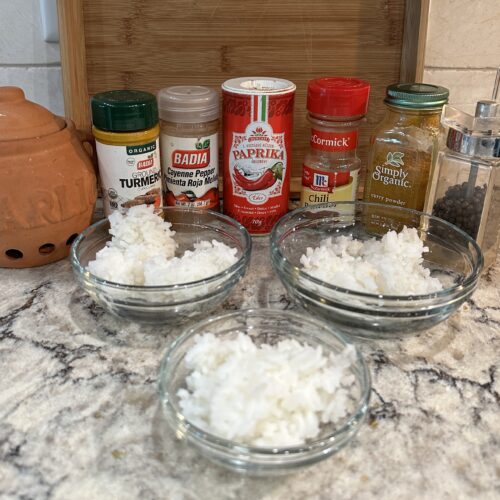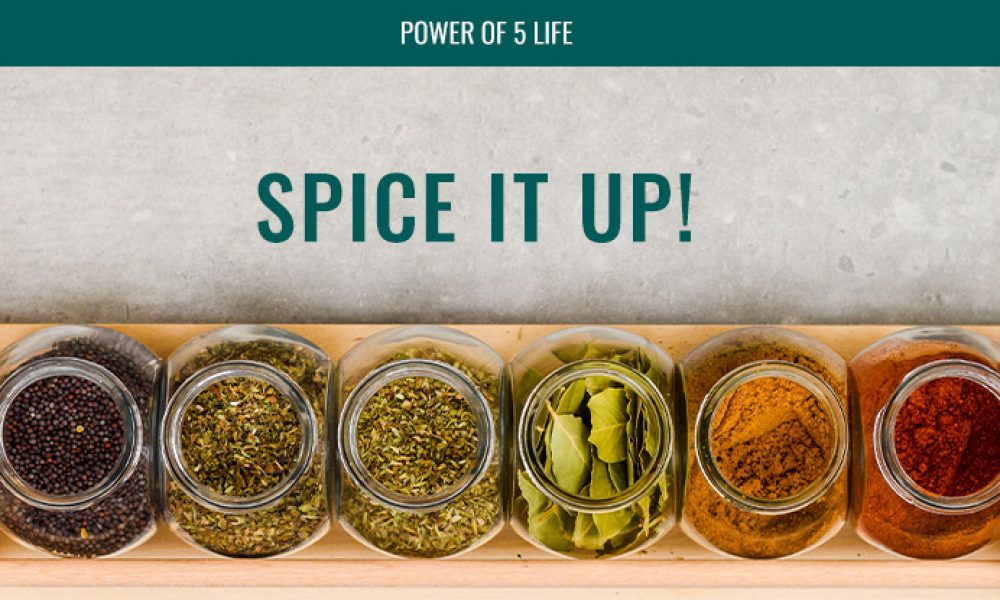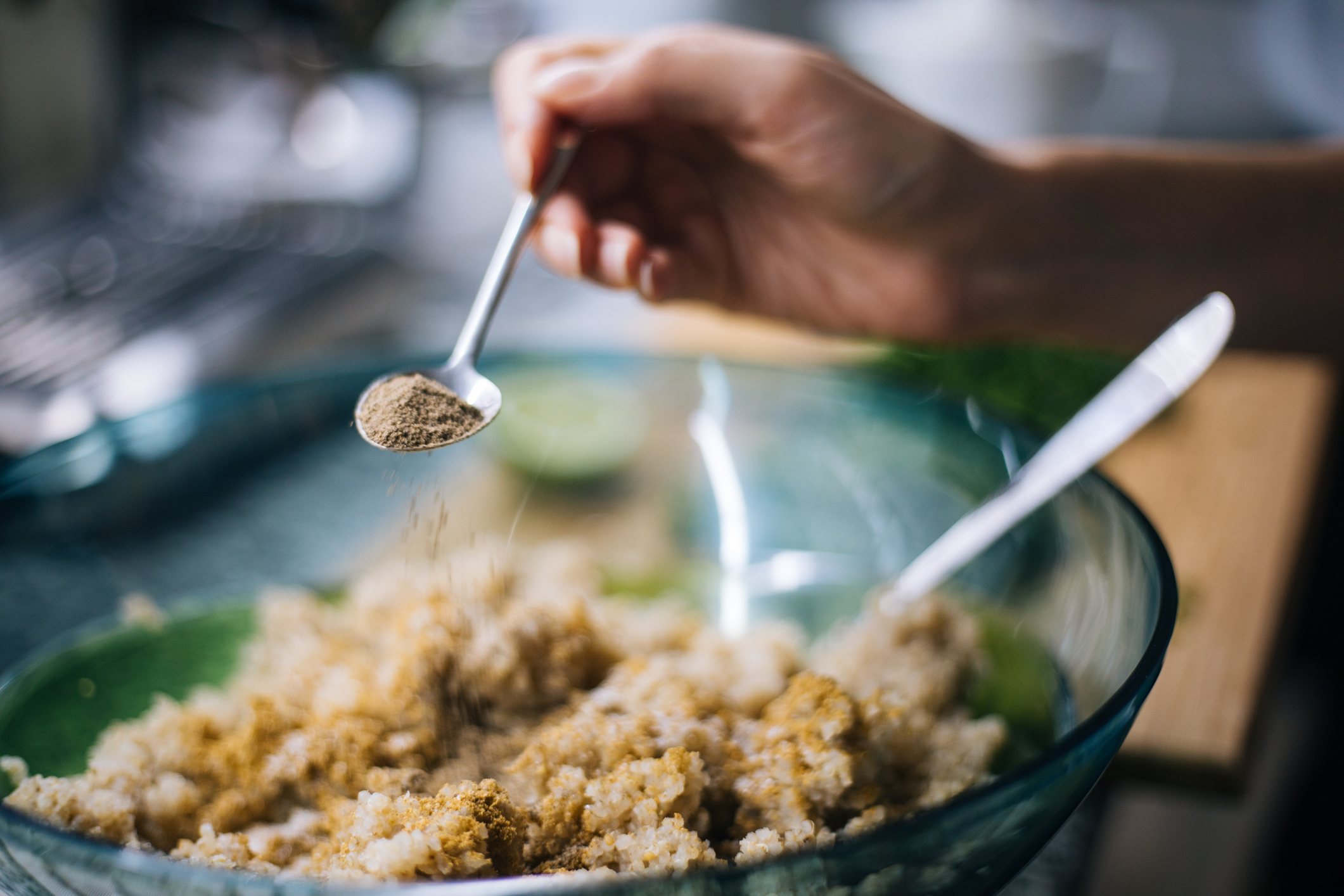During my cooking over the years, I have come to enjoy experimenting with spices and herbs in my laboratory kitchen … my Power of 5 Test Kitchen. From that experimentation, there are 12 spices that I recommend in my most recent cookbook, Power of 5 Test Kitchen Cookbook, Your Guide to Healthy Cooking and Eating.
Why? Because herbs and spices provide health benefits when added to foods while also enhancing tastes. Medicinal values go back centuries from all parts of the globe and influence the herbs and spices we use today.
Top 12 Spices and Herbs for Powerful, Science-backed Health Benefits!
1. Basil
Antibacterial and anti-inflammatory, shown to protect liver health
2. Black pepper
Anti-inflammatory, powerful antioxidant, promotes brain health, improves blood sugar control, and anticancer
3. Cayenne pepper
Powerful antioxidant, promotes cell health, protects your heart, improves digestion, lowers blood pressure, and anticancer
4. Cinnamon
Helps to lower blood sugar, anti-diabetic effect, lowers cholesterol and triglycerides in the blood; cinnamon has antioxidants to help fight inflammation
5. Garlic
The smell is from the compound allicin; it is well-known to combat sickness and even the common cold; garlic is an antibacterial, anti-inflammatory, and contributes to cardiovascular health
6. Ginger
Anti-nausea, strong anti-inflammatory properties, can help with osteoarthritis, helps to fight infection, anticancer, may improve brain function, and helps protect against Alzheimer’s disease
7. Nutmeg
Powerful antioxidant, antibacterial, promotes heart health, and may improve blood sugar control
8. Peppermint
Anti-nausea and improves pain management in irritable bowel syndrome (IBS)
9. Rosemary
Rich source of antioxidants, boosts immune system, and improves blood circulation
10. Sage
Improves brain health and memory and is an anti-inflammatory and antioxidant
11. Turmeric
Anticancer; curcumin, found in turmeric, has special anti-inflammatory powers
12. Cumin
Promotes digestion, anti-inflammatory, anticancer, controls blood sugar, and helps to lower cholesterol
https://www.healthline.com/nutrition/10-healthy-herbs-and-spices
https://www.ncbi.nlm.nih.gov/pmc/articles
https://health.clevelandclinic.org/
My Go-to Spices & Herbs and How I Use Them
Spices and herbs that I use most in my cooking depend on the dish and region of the country it comes from. There are 5 that are constants in my cooking with amounts in varying degrees based on how spicy, sweet or savory I choose for the dish.
Here are my 10 favorites and how I use them in cooking.
Basil – Sweet, savory and can be used in a variety of dishes: vegetables, pasta, chicken or fish meals, tomato sauce, and salads. Use at the end of cooking time or once it is prepared.
Black pepper – Ground or peppercorns add flavors to just about any recipe. Soups, dressing, sauces, vegetables, poultry, seafood, stir fry, pasta, eggs, and avocado toast.
Chili pepper – Ground, whole, and fresh can be mild to very hot. Use in soups, stews, sauces, poultry, seafood, or any dish to give it a more subtle kick of heat.
Cayenne pepper – Ground cayenne pepper powder is much hotter than chili peppers. Sometimes it includes a blend of cumin, paprika, garlic, and onion powder. Use in soups, stews, sauces, poultry, seafood, or any dish to give it a big kick of heat.
Cinnamon – Sticks, bark or ground cinnamon have a sweet yet strong flavor. Use in cookies, baked goods, protein shakes, sauces, vegetables, apples, pumpkin, and squash. I love to add it to soups as it adds a lovely flavor.
Garlic – Cloves, minced, or garlic powder are great in everything. From cooked to raw garlic, it adds flavor to soups, stews, poultry, seafood, casseroles, and Italian recipes. I use a lot of garlic in various forms.
Ginger – Fresh, dried or ground ginger is great in Asian dishes, seafood, poultry, soups, vegetables, baked goods, and beverages (teas or protein shakes).
Paprika – Red mild, smoked or spicy powders typically. However, I bought infused paprika oil when I was in Hungary. I learned they infused the seeds in oil to make a delicious paprika oil. Just a few drops is all you need for quite a spicy hot flavor!
Turmeric – Orange power with a mild flavor used in curries, soups, stew, casseroles.
Cumin – Seeds or ground, cumin has a very bold, distinctive flavor. Use cumin in chili and Mexican dishes such as tacos and fajitas.
Curry – A potpourri of several spices, curries vary based on regional cooking (Indian, Asian, Japanese). Curries may include cayenne pepper, chili powder, turmeric, cumin, paprika, garlic, cinnamon, cloves, mustard seed, fennel seed, and black pepper.
To Healthy Cooking & Eating!
Melissa

Taste Test Herbs and Spices with White Rice!
Equipment
- 8- or 9-quart pot to cook on stovetop OR
- Rice cooker, if you have one OR
- Instant Pot, if you have one
- Small bowls – the number of bowls you'll need will depend on how many spices you are taste testing
- Forks and/or spoons
- * Pencil & Paper To take notes of what spices you like and which ones you do not for future cooking!
Ingredients
- 2 Cups Rice white dry
- Dashes Spices and herbs of your choice to test
Instructions
- Cook a big batch of white rice as directed on the package, any white rice will do.
- Set-up your mise en place of spices you want to try and bowls where the rice will be placed once cooked.
- Scoop a small amt of rice into each bowl. Organize your small bowls of white rice to taste test.
- Try one spice at a time. Make your notes, then try the next spice. You may want to take a sip of water in between tastes to clean your pallet.



